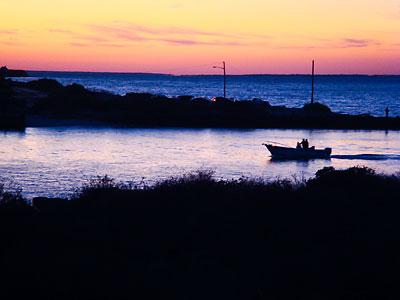Waiting for the Alewives

Spring, the vernal equinox, the season of rebirth, sprang in the early morning hours on Tuesday with its promise that all living things, including fish, will return for another go-round.
Every culture has celebrated the equinox — when the center of the sun is on the same plane as the earth’s equator — in one way or another, even in Amagansett. One such annual fete took place in the home of Harvey Bennett, owner of the Tackle Shop in Amagansett. According to Bennett, the solemn ceremony went like this:
“Well, I’ve really lost it this time. At 1:14 a.m. this morning with the help of some leftover St. Pat’s whiskey, I stood an egg on end! Then I tried standing a broom on end (which is something else one can do when all things are in balance and equal). Well, the egg stood, but I have to work on the broom. So now I’m hung over to beat the band, and for the third year in a row I stood an egg on end on the vernal equinox (see YouTube, ‘Harvey Bennett the Tackle Shop’). Happy spring, everyone.”
This week, spring things included a whale cruising less than a mile offshore of Ditch Plain in Montauk.
Alewives apparently have not gotten the message, at least east of Southampton. They have been seen making their spawning runs up various streams there, and the watch is on at Ligonee Creek in Sag Harbor. The brook, part of the Long Pond Greenbelt, has been cleared of debris with the help of the Southampton Town Trustees.
“A lot died last year trying to get up there. It was treacherous. The Peconic Estuary Program people are studying how to improve the access,” said Larry Penny, East Hampton’s former director of natural resources. So far no scales or dead bodies have been seen along the creek banks (a natural occurrence), Penny said. He added that East Hampton’s spawning tributaries were in bad need of improvement.
The creek flows into Upper Sag Harbor Cove, always a likely spot for striped bass to show up early. These are thought to be resident bass that start moving around this time of year — although we must remember that “this time of year” has come early in 2012, temperature-wise.
Howard Reisman of North Sea has reported seeing ospreys and herons on the hunt, a sure sign that alewives have arrived. Alewives and other herring-type fish normally time their arrival for the second or third week of April.
Given the unseasonable season, “there should be bass all over the place. The water temperature never dropped. The harbors never froze. I never had daffodils in February before. Maybe you could find bass in Eel Pond on Napeague, where the water warms up real quick,” Bennett suggested.
Those who can’t wait to wet a hook might try fishing for pickerel in Scoy Pond in the Grace Estate. A little spoon or snapper lure should work. Pickerel get as big as three pounds and are known to jump and tail walk like mini sailfish. Otherwise, the start of the winter flounder season is only 10 days away, on April 1.
Here are the seasons, minimum size, and bag limits published by the State Department of Environmental Conservation for 2012:
The summer flounder (fluke) season will run from May 1 to Sept. 30. Three fish at 20.5 inches may be kept per day.
Blackfish, four at 16 inches, from Oct. 8 to Dec. 4.
Bluefish, no minimum size for the first 10, then 12 inches for the next 5 for a total of 15 per day.
Weakfish, 16 inches, one per day, year round.
Cod, 22 inches, 10 per day (more on a charter or party boat), year round.
Pollock, 19 inches, no bag limit, year round.
Striped bass, 28 inches, one per day for most anglers, two per day for those fishing on charter or party boats, from April 15 to Dec. 15.
The first half of the porgy season will begin on June 13 and run to Oct. 1. For those fishing from for-hire boats, 10 may be caught and kept per day if they are at least 11 inches long. From Sept. 7 to Oct. 11, up to 40 porgies may be caught per day. Private boaters may keep 10 porgies at 10.5 inches from May 24 to Sept. 6.
Blue crabs — yum! — will have to be four-and-a-half inches across the carapace. Fifty per day may be caught, year round.
